Use of Internet of Things in enterprises
Data extracted in May 2022
Planned article update: May 2025
Highlights
In 2021, 29 % of EU enterprises used Internet of Things devices, mostly for keeping their premises secure.
In 2021, the percentage of large enterprises using the Internet of Things was 48% compared with 26% for small enterprises.
Enterprises using IoT, 2021
This article presents recent statistics on the use of Internet of Things devices and systems in enterprises in the European Union (EU).
The Internet of Things (IoT) refers to a network of interconnected – or ‘smart’ – devices or systems. Sensors, software and other technologies are embedded in devices to collect, connect with and exchange data with other devices or systems. IoT devices and systems can be monitored and remotely controlled through the internet.
Examples of IoT devices and systems are
- smart meters, thermostats, lamps (lights), alarm systems, smoke detectors, door locks and cameras
- sensors and RFID (radio-frequency identification) tags connected to a connection point (or base station), which makes it possible to manage them through the internet.
Enterprises use interconnected devices and systems for different reasons, including securing their premises, optimising energy consumption, streamlining production and logistics, supporting customer service and improving maintenance of machines or vehicles.
Full article
Enterprises using IoT
In 2021, 29 % of EU enterprises with 10 or more employees and self-employed persons used IoT devices or systems. The vast majority used cameras and other devices to secure their premises (72 %). To a lesser extent, enterprises used smart meters and smart lights to optimise their energy consumption (30 %) or sensors to monitor the real-time condition of equipment (condition-based maintenance) (24 %), see Table 1.
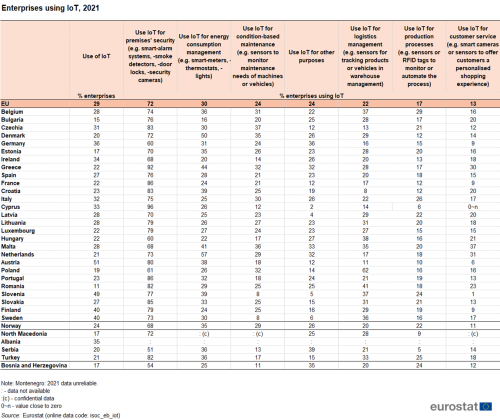
(% enterprises and % enterprises using IoT)
Source: Eurostat (isoc_eb_iot)
In the EU, more than half of enterprises in Austria (51 %) used IoT devices or systems in 2021. Close behind were Slovenia (49 %), Finland and Sweden (both 40 %). However, the use of IoT is not as prevalent in other Member States: less than 20 % of enterprises in Poland (19 %), Estonia (17 %), Bulgaria (15 %), and Romania (11 %) used these devices or systems (see Figure 1).

(% enterprises)
Source: Eurostat (isoc_eb_iot)alt= a vertical bar chart showing enterprises using IoT in the year 2021 in the EU, EU Member States, Norway some candidate countries and potential countries.
Depending on an enterprise’s size, there can be significant differences in the use of IoT (see Figure 2). In 2021, just over a quarter (26 %) of small enterprises used IoT, while large enterprises used it almost twice as much (48 %). In medium-sized enterprises, nearly 2 out of 5 (37 %) used IoT.
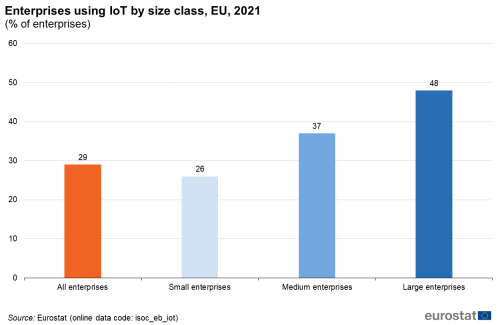
(% enterprises)
Source: Eurostat (isoc_eb_iot)
Figure 3 shows the use of IoT across different economic sectors in 2021. Around 46 % of enterprises in the electricity, gas, steam, air conditioning and water supply sector reported using interconnected devices and systems. IoT was also used in more than one third of enterprises in the accommodation sector (36 %) and the information and communication sector (34 %). The lowest rates of IoT use were in administrative and support service activities (24 %) and professional, scientific and technical activities (25 %).
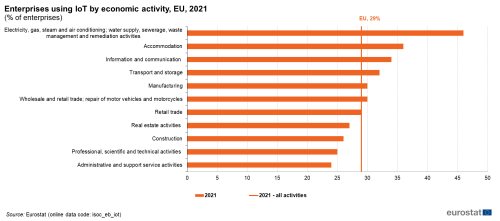
(% enterprises)
Source: Eurostat (isoc_eb_iot)
Purpose of using IoT
In enterprises, IoT is used for different purposes to improve business processes, reduce costs or increase efficiency. Almost three quarters of enterprises using IoT in 2021 did so to secure their premises (72 %). The use of security IoT devices was the same for both small and large enterprises (72 % each). For nearly one third of enterprises using IoT (30 %) the purpose was to manage energy consumption in their premises (e.g. smart meters, smart thermostats or smart lights). This was more common in large enterprises (56 %) than in small enterprises (26 %). Similarly, compared to small enterprises, the percentage of large enterprises was twice as high for those using IoT for condition-based maintenance (44 % for large and 22 % for small enterprises) or production processes (36 % for large and 15 % for small enterprises) (see Figure 4).
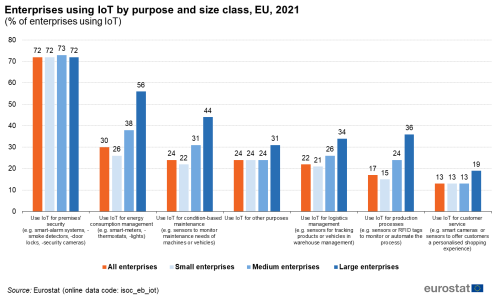
(% of enterprises using IoT)
Source: Eurostat (isoc_eb_iot)
In 2021, the main purpose among enterprises in all economic sectors for using IoT was to keep their premises secure. This ranged from 79 % in the retail trade sector to 61 % in the transport and storage sector.
IoT devices for managing energy consumption were mostly used by enterprises in the accommodation sector (48 %) and in real estate activities (45 %). The use of IoT for production processes was highest in the electricity, gas, steam, air conditioning and water supply sector (34 %) and in the manufacturing sector (32 %). IoT devices for logistics management were used the most in the transport and storage sector (61 %). IoT for condition-based maintenance of machines or vehicles were mostly used in the electricity, gas, steam, air conditioning and water supply sector (41 %). Furthermore, 22 % of enterprises in the accommodation sector used interconnected devices for customer service (to monitor customer activity or offer personalised shopping).
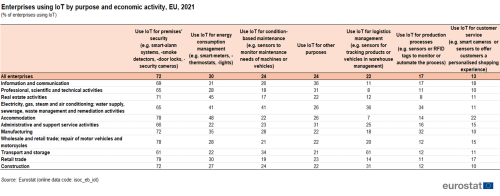
(% of enterprises using IoT)
Source: Eurostat (isoc_eb_iot):
Source data for tables and graphs
Data sources
Data presented in this article are based on the results of the 2021 survey on ICT usage and e-commerce in enterprises. Statistics were obtained from surveys conducted by the national statistical authorities in early 2021.
In 2021, 148 000 of the 1.5 million enterprises in the EU were surveyed. Of these enterprises, approximately 83 % were small enterprises (10-49 employees and self-employed persons), 14 % medium enterprises (50-249 employees and self-employed persons) and 3 % large enterprises (250 or more employees and self-employed persons).
Source data shown as ':' refer to data that are unavailable, unreliable, confidential or not applicable. Unreliable data are included in the calculation of European aggregates. Data presented in this article may differ from the data in the database because of updates made after the data were extracted for this article. Data in the database are organised according to the survey year. The observation statistical unit is the enterprise, as defined under Regulation (EC) No 696/1993 of 15 March 1993. The survey covered enterprises with at least 10 employees and self-employed persons. Economic activities correspond to the NACE Revision 2 classification. The sectors covered are
- manufacturing
- electricity, gas and steam, air conditioning and water supply
- construction
- wholesale and retail trades, repair of motor vehicles and motorcycles
- transportation and storage
- accommodation and food service activities
- information and communication; real estate
- professional, scientific and technical activities
- administrative and support activities
- repair of computers and communication equipment.
Context
In 2019, the Commission President, Ursula von der Leyen, described how she wanted the EU to grasp the opportunities presented by the digital age. A Europe fit for the digital age is one of 6 Commission priorities for 2019-2024. This digital transformation is based on the idea that digital technologies and solutions should
- open up new opportunities for businesses
- boost the development of trustworthy technology
- foster an open and democratic society
- enable a vibrant and sustainable economy
- and help fight climate change.
In 2021, the Digital Compass for the EU's Digital Decade (COM(2021)118 final), set the EU’s digital targets for 2030 around 4 cardinal points: skills, digital transformation of businesses, secure and sustainable digital infrastructures, and digitalisation of public services.
Direct access to
See also
- Use of artificial intelligence in enterprises
- Cloud computing - statistics on the use by enterprises
- E-business integration
- E-commerce statistics
- ICT security in enterprises
- Social media - statistics on the use by enterprises
- ICT specialists - statistics on hard-to-fill vacancies in enterprises
- Digital economy and society statistics - enterprises
Main tables
Dedicated section
Methodology
- ICT usage and e-commerce in enterprises (ESMS metadata file — isoc_e_esms)
Legislation
- Regulation (EU) 2019/2152 of the European Parliament and of the Council of 27 November 2019 on European business statistics
- Regulation (EC) No 808/2004 of the European Parliament and of the Council of 21 April 2004 concerning Community statistics on the information society
- Regulation (EC) No 960/2008 of 30 September 2008 implementing Regulation (EC) No 808/2004 concerning Community statistics on the information society
- Regulation (EC) No 1023/2009 of 29 October 2009 implementing Regulation (EC) No 808/2004 concerning Community statistics on the information society
- Regulation (EU) No 821/2010 of 17 September 2010 implementing Regulation (EC) No 808/2004 concerning Community statistics on the information society
- Regulation (EU) No 937/2011 of 21 September 2011 implementing Regulation (EC) No 808/2004 concerning Community statistics on the information society
- Regulation (EU) No 1083/2012 of 19 November 2012 implementing Regulation (EC) No 808/2004 concerning Community statistics on the information society
- Regulation (EU) No 859/2013 of 5 September 2013 implementing Regulation (EC) No 808/2004 concerning Community statistics on the information society
- Regulation (EU) No 1196/2014 of 30 October 2014 implementing Regulation (EC) No 808/2004 concerning Community statistics on the information society
- Regulation (EU) 2015/2003 of 10 November 2015 implementing Regulation (EC) No 808/2004 concerning Community statistics on the information society
- Regulation (EU) 2016/2015 of 17 November 2016 implementing Regulation (EC) No 808/2004 concerning Community statistics on the information society
- Regulation (EU) 2017/1515 of 31 August 2017 implementing Regulation (EC) No 808/2004 concerning Community statistics on the information society
- Regulation (EU) 2018/1798 of 21 November 2018 implementing Regulation (EC) No 808/2004 of the European Parliament and of the Council concerning Community statistics on the information society for the reference year 2019
- Regulation (EU) 2019/1910 of 7 November 2019 implementing Regulation (EC) No 808/2004 of the European Parliament and of the Council concerning Community statistics on the information society for reference year 2020
- Regulation (EU) 2020/1030 of 15 July 2020 laying down the technical specifications of data requirements for the topic ‘ICT usage and e-commerce’ for the reference year 2021, pursuant to Regulation (EU) 2019/2152 of the European Parliament and of the Council
- Regulation (EU) 2021/1190 of 15 July 2021 laying down the technical specifications of data requirements for the topic ‘ICT usage and e-commerce’ for the reference year 2022 pursuant to Regulation (EU) 2019/2152 of the European Parliament and of the Council
External links